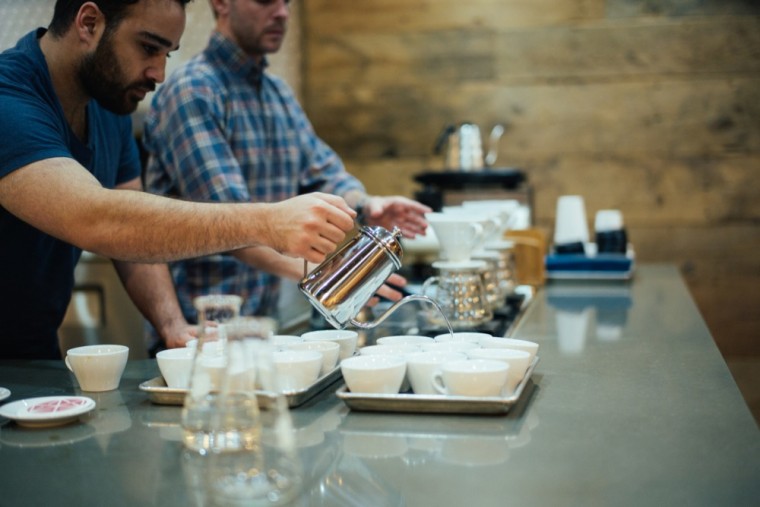Scene
In search of the perfect brew: An investigation at Blueprint Coffee
Modern American culture seems to have deemed gastronomic precision in vogue. The finest restaurants all must be locally sourced and organic. The classic, conservative combo of coffee and doughnuts has become an opportunity for classiness. Take a trip to Vincent Van Doughnut in Clayton to see fried dough baked and sculpted into pieces of edible art. Or go, as I did, to Blueprint Coffee’s seasonal coffee tasting to see how far a cup of joe really can go.
 Joachim Vaturi | Student Life
Joachim Vaturi | Student Life Blueprint Coffee hosted a fresh crop tasting on Monday, September 21st. Their latest round of coffees include crops from Mexico and Ethiopia.
I should say now that I used to work in a coffee shop. And it wasn’t some average Dunkin’ Donuts type of place either. To sum it up, the owner described one coffee as “very smooth, with a long finish, like a Bordeaux.” My former place of employment was among the ever-increasing crowds decreeing that Starbucks is not enough. But I never claimed to be won over—I just served the stuff. Honestly, I wasn’t positive I could taste a difference between 7-Eleven coffee and the $4 brew I sold. Without a direct comparison of the two, I couldn’t be sure.
Still, I went into this tasting with an open mind. It’s nice to think that everyday customers of fancy coffee aren’t, in fact, getting swindled. The full crew of baristas had the modern industrial interior spotless and waiting for us right at 8 p.m. on Monday, the night of the event. Many of the 20-some-odd tasters seemed to be friends of the baristas, with a few older couples and one other group of students. Mike Marquard, the owner of Blueprint, began the night describing the Decaf Tecpatlan, with a five- to 10-minute story behind the beans and production, chronicling the journey from the Puebla Mexican farm to our awaiting cups.
This first coffee was mild; it was precisely what my tongue expected when I imagined the taste of coffee. Nothing too special, by any means. Would I pay $4 to $5 for it? Honestly, probably not.
 Joachim Vaturi | Student Life
Joachim Vaturi | Student Life The baristas use V60 ceramic coffee drippers. When asked why they used these, rather than the other, classy options like the French press, Marquard said that they provide a greater opportunity for accuracy and consistency, but they are also just in fashion now. The pour-over systems are nothing new, but they have recently, like so much else, become “vintage” rather than “dated” systems. You’ll see them at all the trendy spots these days.
But when you get right down to it, all of that means nothing if the coffee can’t deliver. There is a video on Blueprint’s website that gives the company’s mantra as “Beauty in Precision.” And no, they don’t also sell Italian cars. But what can this focus (or obsession) really do?
The next coffee was the Hambela, from Ethiopia. African coffees, I was told, promised more diverse flavors—or notes—and could vary wildly in profile. And to my amazement, I hated it. It was acidic and fruity and all too much for my moderate palate. But the final regular coffee was the Santa Teresa, which I loved—it was a perfect balance between the two prior, slightly fruity and still distinctly coffee-flavored. So one was neutral, one was bad and one was good. Blueprint was batting .500. But the fact that I could notice such a difference between the coffees that—mind you—were prepared to exacting standards, such that one, though only one, repulsed me suggests that there really is something in this process and in this coffee.
I’ll admit, I couldn’t taste the specific “notes” in these coffees, even when I searched for them on a second taste. But I could honestly see where they were coming from. Never before had I experienced such varied tastes of what was called coffee. For me, this custom, high-class coffee is worth some experimentation—some additional tests.
But next, of course, are those doughnuts.
